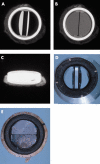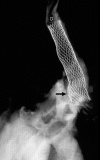Analysis of prosthetic cardiac devices: a guide for the practising pathologist
- PMID: 15677529
- PMCID: PMC1770567
- DOI: 10.1136/jcp.2004.020271
Analysis of prosthetic cardiac devices: a guide for the practising pathologist
Abstract
Pathologists all over the world increasingly encounter prosthetic cardiac devices. A good evaluation of these devices is a valuable source of information, which can contribute to patient care and the appreciation and understanding of the pathobiology involved in the changes occurring between the host and the implanted prosthetic device. This article summarises the considerations underlying the analysis of prosthetic devices (particularly prosthetic heart valves), including the identification of the devices, the major morphological features of the devices, their modes of failure, and some technical details about evaluation and pitfalls.
Figures




















Similar articles
-
The failure modes of biological prosthetic heart valves.J Long Term Eff Med Implants. 2001;11(3-4):115-35. J Long Term Eff Med Implants. 2001. PMID: 11921659 Review.
-
[Progress in prosthetic heart valves].Nihon Rinsho. 1986 Jul;44(7):1698-707. Nihon Rinsho. 1986. PMID: 3531626 Review. Japanese. No abstract available.
-
The influence of design on bioprosthetic valve durability.J Long Term Eff Med Implants. 2001;11(3-4):137-49. J Long Term Eff Med Implants. 2001. PMID: 11921660 Review.
-
Haemodynamic evaluation of the Hancock bovine pericardial heart valve.Z Kardiol. 1986;75 Suppl 2:241-4. Z Kardiol. 1986. PMID: 3727694 No abstract available.
-
Are bioprostheses superior to mechanical valves?Z Kardiol. 1986;75 Suppl 2:286-8. Z Kardiol. 1986. PMID: 3727703
Cited by
-
Biocompatibility and biofilm inhibition of N,N-hexyl,methyl-polyethylenimine bonded to Boston Keratoprosthesis materials.Biomaterials. 2011 Dec;32(34):8783-96. doi: 10.1016/j.biomaterials.2011.08.010. Epub 2011 Sep 7. Biomaterials. 2011. PMID: 21903257 Free PMC article.
-
Material Safety of Styrene-Block-Ethylene/Butylene-Block-Styrene Copolymers Used for Cardiac Valves: 6-Month In Vivo Results from a Juvenile Sheep Model.Eur J Cardiothorac Surg. 2025 Aug 2;67(8):ezaf266. doi: 10.1093/ejcts/ezaf266. Eur J Cardiothorac Surg. 2025. PMID: 40748729 Free PMC article.
-
Pathology of the Aortic Valve: Aortic Valve Stenosis/Aortic Regurgitation.Curr Cardiol Rep. 2019 Jul 5;21(8):81. doi: 10.1007/s11886-019-1162-4. Curr Cardiol Rep. 2019. PMID: 31278595 Review.
-
Trends in complications of cardiac and vascular prosthetic devices, implants, and grafts mortality rate in the United States (1999-2020).Ann Med Surg (Lond). 2025 Jan 9;87(1):234-241. doi: 10.1097/MS9.0000000000002850. eCollection 2025 Jan. Ann Med Surg (Lond). 2025. PMID: 40109635 Free PMC article. Review.
References
-
- Rahimtoola SH. Vasodilator therapy in chronic severe aortic regurgitation. J Am Coll Cardiol 1990;16:430–2. - PubMed
-
- Schoen FJ. Approach to the analysis of cardiac valve prostheses as surgical pathology or autopsy specimens. Cardiovasc Pathol 1995;4:241–55. - PubMed
-
- Savage R . New law to require medical device injury reports. CAP Today 1991;40.
-
- Butany J, Fayet C, Ahluwalia MS, et al. Biological replacement heart valves. Identification and evaluation. Cardiovasc Pathol 2003;12:119–39. - PubMed
-
- Butany J, Ahluwalia MS, Munroe C, et al. Mechanical heart valve prostheses: identification and evaluation [erratum]. Cardiovasc Pathol 2003;12:322–44. - PubMed
Publication types
MeSH terms
LinkOut - more resources
Full Text Sources
Other Literature Sources
